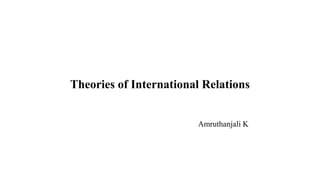
Theories of International Relations.pptx
- 1. Theories of International Relations Amruthanjali K
- 2. Realism • Also known as political realism emphasizes the competitive and conflictual side of international relations. • It’s contrasted with idealism or liberalism which tends to emphasize cooperation. • Realists consider the principal actors in the international arena to be states, which are concerned with their own security, act in pursuit of their own national interests, and struggle for power. • Realism can be comprehended from the 19th century European politics where power was one of the main issues that brought about conflict between European nations. • It believes that power is strongly founded in military dominance of a given state over other states.
- 3. • Most of the actions in relations between states justify the search for power and the need to increase power of states. • Recent wars such as US war on Iraq and US war in Afghanistan are forms of actions that shows the power through military dominance.
- 4. Liberalism • Liberalism suggests in fact states can peacefully co-exist, and that states aren’t always on the brink of war. • Liberalists explain power in terms of the diverse activities that takes place in the interaction among states. • According to them, power includes aspects like trade, cultural interaction and cooperate advancements etc. It embraces openness in the relations between states, which gives states a chance to prosper in the social and economic realms. • States obtain power through means other than military dominance. • It emphasises that rather than focussing on war, states should seek to use diplomacy, international institutions, and commerce as ways of building peaceful relationships with other states.
- 5. Constructivism • The term constructivism was adopted in 1989 and introduced as “people and societies construct or constitute each other”. • The main assumption of constructivists is that the fundamental structures of international politics are social and these structures shape actors’ identities and interests • It states that the essence of international relations exists in the interactions between people. The states do not interact; it is the agents of those states, such as politicians and diplomats, who interact. • The belief that the reality is socially constructed leads constructivists to place a greater role on norm development, identity and ideational power. • It recognizes the significance of nonmaterial power (culture, ideas, languages and ideology) as well as material power because the two powers connect and interact to build the world order.
- 6. Kingdon’s Policy Theory • Kingdon suggests that policy change comes about when three streams- problems, politics and policies connect. • This model shows that while the three streams may be operating independently of one another, all three need to come together in order for a policy to emerge. • Problem stream: highlighting the issue • Political stream: political stability, political will, legislations • Policy stream: international technical or financial support, regional and international conferences, national plans • Opening a window of opportunity: joining the above three streams lead to restructuring of the decision agenda.
- 8. References: • Policy models: https://www.policy.nl.ca/policydevelopment/pages/policymodels.html • International relations theory: https://www.e-ir.info/2017/01/09/international- reltions-theory/ • Constructivism in international relations: https://www.ia.forum.org/Content/ViewInternal_Document.cfm?contenttype_id=5 &ContentID=8773 • Kingdon’s three stream policy window model: https://rameshdthakur.wordpress.com/2014/03/30/kingdons-three-stream-policy- window-model-and-cardiac-rehabilitation-policy/